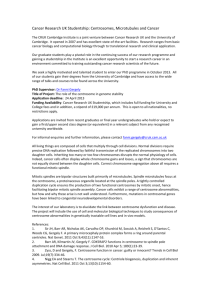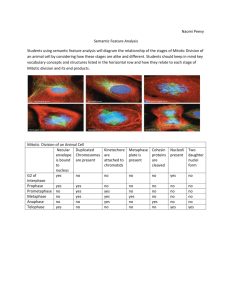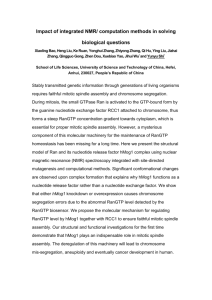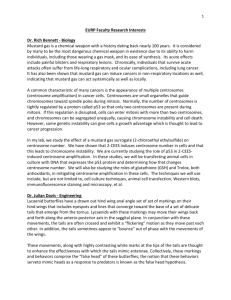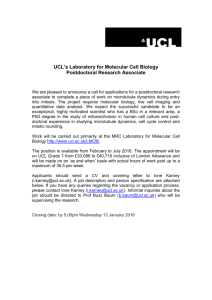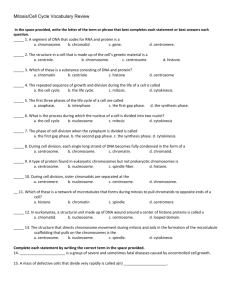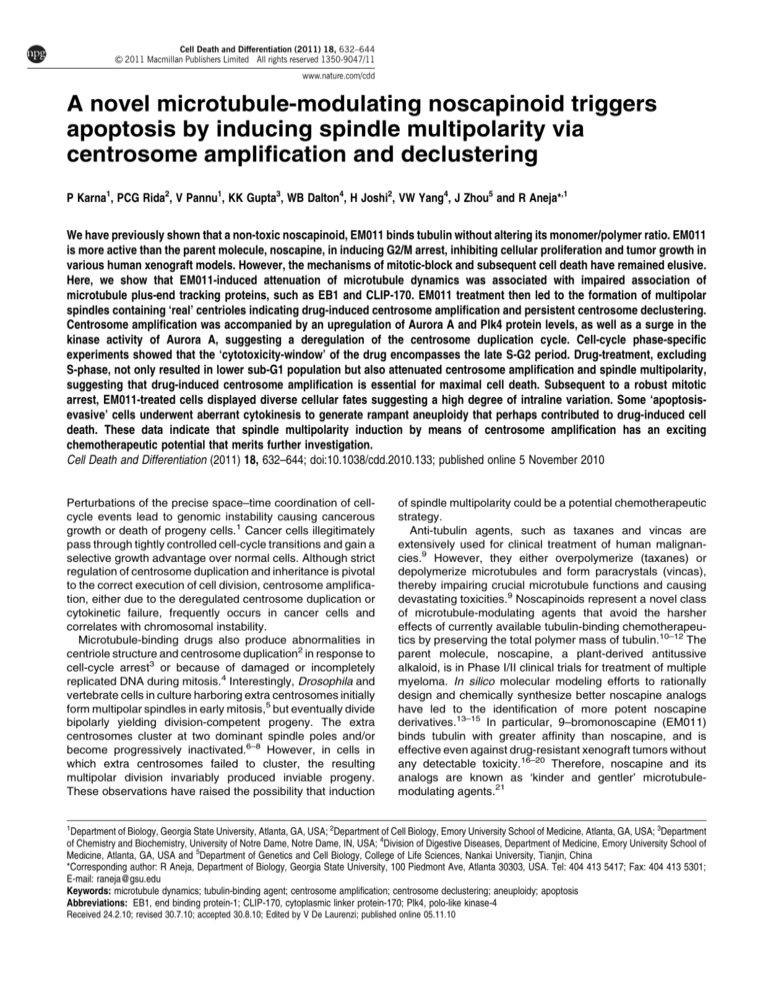
Cell Death and Differentiation (2011) 18, 632–644
& 2011 Macmillan Publishers Limited All rights reserved 1350-9047/11
www.nature.com/cdd
A novel microtubule-modulating noscapinoid triggers
apoptosis by inducing spindle multipolarity via
centrosome amplification and declustering
P Karna1, PCG Rida2, V Pannu1, KK Gupta3, WB Dalton4, H Joshi2, VW Yang4, J Zhou5 and R Aneja*,1
We have previously shown that a non-toxic noscapinoid, EM011 binds tubulin without altering its monomer/polymer ratio. EM011
is more active than the parent molecule, noscapine, in inducing G2/M arrest, inhibiting cellular proliferation and tumor growth in
various human xenograft models. However, the mechanisms of mitotic-block and subsequent cell death have remained elusive.
Here, we show that EM011-induced attenuation of microtubule dynamics was associated with impaired association of
microtubule plus-end tracking proteins, such as EB1 and CLIP-170. EM011 treatment then led to the formation of multipolar
spindles containing ‘real’ centrioles indicating drug-induced centrosome amplification and persistent centrosome declustering.
Centrosome amplification was accompanied by an upregulation of Aurora A and Plk4 protein levels, as well as a surge in the
kinase activity of Aurora A, suggesting a deregulation of the centrosome duplication cycle. Cell-cycle phase-specific
experiments showed that the ‘cytotoxicity-window’ of the drug encompasses the late S-G2 period. Drug-treatment, excluding
S-phase, not only resulted in lower sub-G1 population but also attenuated centrosome amplification and spindle multipolarity,
suggesting that drug-induced centrosome amplification is essential for maximal cell death. Subsequent to a robust mitotic
arrest, EM011-treated cells displayed diverse cellular fates suggesting a high degree of intraline variation. Some ‘apoptosisevasive’ cells underwent aberrant cytokinesis to generate rampant aneuploidy that perhaps contributed to drug-induced cell
death. These data indicate that spindle multipolarity induction by means of centrosome amplification has an exciting
chemotherapeutic potential that merits further investigation.
Cell Death and Differentiation (2011) 18, 632–644; doi:10.1038/cdd.2010.133; published online 5 November 2010
Perturbations of the precise space–time coordination of cellcycle events lead to genomic instability causing cancerous
growth or death of progeny cells.1 Cancer cells illegitimately
pass through tightly controlled cell-cycle transitions and gain a
selective growth advantage over normal cells. Although strict
regulation of centrosome duplication and inheritance is pivotal
to the correct execution of cell division, centrosome amplification, either due to the deregulated centrosome duplication or
cytokinetic failure, frequently occurs in cancer cells and
correlates with chromosomal instability.
Microtubule-binding drugs also produce abnormalities in
centriole structure and centrosome duplication2 in response to
cell-cycle arrest3 or because of damaged or incompletely
replicated DNA during mitosis.4 Interestingly, Drosophila and
vertebrate cells in culture harboring extra centrosomes initially
form multipolar spindles in early mitosis,5 but eventually divide
bipolarly yielding division-competent progeny. The extra
centrosomes cluster at two dominant spindle poles and/or
become progressively inactivated.6–8 However, in cells in
which extra centrosomes failed to cluster, the resulting
multipolar division invariably produced inviable progeny.
These observations have raised the possibility that induction
of spindle multipolarity could be a potential chemotherapeutic
strategy.
Anti-tubulin agents, such as taxanes and vincas are
extensively used for clinical treatment of human malignancies.9 However, they either overpolymerize (taxanes) or
depolymerize microtubules and form paracrystals (vincas),
thereby impairing crucial microtubule functions and causing
devastating toxicities.9 Noscapinoids represent a novel class
of microtubule-modulating agents that avoid the harsher
effects of currently available tubulin-binding chemotherapeutics by preserving the total polymer mass of tubulin.10–12 The
parent molecule, noscapine, a plant-derived antitussive
alkaloid, is in Phase I/II clinical trials for treatment of multiple
myeloma. In silico molecular modeling efforts to rationally
design and chemically synthesize better noscapine analogs
have led to the identification of more potent noscapine
derivatives.13–15 In particular, 9–bromonoscapine (EM011)
binds tubulin with greater affinity than noscapine, and is
effective even against drug-resistant xenograft tumors without
any detectable toxicity.16–20 Therefore, noscapine and its
analogs are known as ‘kinder and gentler’ microtubulemodulating agents.21
1
Department of Biology, Georgia State University, Atlanta, GA, USA; 2Department of Cell Biology, Emory University School of Medicine, Atlanta, GA, USA; 3Department
of Chemistry and Biochemistry, University of Notre Dame, Notre Dame, IN, USA; 4Division of Digestive Diseases, Department of Medicine, Emory University School of
Medicine, Atlanta, GA, USA and 5Department of Genetics and Cell Biology, College of Life Sciences, Nankai University, Tianjin, China
*Corresponding author: R Aneja, Department of Biology, Georgia State University, 100 Piedmont Ave, Atlanta 30303, USA. Tel: 404 413 5417; Fax: 404 413 5301;
E-mail: raneja@gsu.edu
Keywords: microtubule dynamics; tubulin-binding agent; centrosome amplification; centrosome declustering; aneuploidy; apoptosis
Abbreviations: EB1, end binding protein-1; CLIP-170, cytoplasmic linker protein-170; Plk4, polo-like kinase-4
Received 24.2.10; revised 30.7.10; accepted 30.8.10; Edited by V De Laurenzi; published online 05.11.10
EM011 induces centrosome amplification
P Karna et al
633
EM011 treatment causes a G2/M arrest in cancer cells
followed by apoptotic cell death.16–22 However, the relationship between mitotic-block and cell death has remained
elusive. In order to understand EM011’s mode of action, we
examined how this drug induces perturbations in the
coordination of mitotic events causing cell-cycle stasis, and
then tips the outcomes in favor of cell death rather than
continued, increasingly aberrant and aggressive proliferation.
We determined the EM011’s effects on cell-cycle progression
and spindle biogenesis and analyzed how it induces
apoptosis. Our data show that EM011 treatment reduces
microtubule dynamicity and deregulates the centrosome
duplication cycle, causing centrosome amplification and
spindle multipolarity. Spindle multipolarity in turn, produces
multiple catastrophic cellular outcomes, culminating in apoptosis induction.
Results
EM011 preserves microtubule ultrastructure. Error-free
mitotic progression requires precise regulation of microtubule
dynamics. As both microtubule-stabilizing and -destabilizing
agents suppress spindle dynamics,23,24 we first asked
whether EM011 mediates cytotoxicity by perturbing
dynamic instability of interphase microtubules in living GFPtubulin expressing MCF-7 cells (Supplementary Movie-1
(control) and Movie-2 (treated), time-lapse movies). In
contrast to control cells in which microtubules alternated
between phases of growth and shortening, with intervening
‘pause’ phases, EM011 treatment attenuated microtubule
dynamics as indicated by largely unaltered position of
microtubule ends at the cell periphery (Figure 1ai). Figure
1aii shows life-history traces of microtubules from control and
treated cells. Supplementary Table 1 shows quantitative
analysis of microtubule growth, shortening, frequencies of
catastrophe and rescue and average duration of pause
phase. We found that EM011 reduced overall dynamicity
by B72% and increased pause duration by B76%. Thus
EM011 decreases the number of dynamic events in the life
history of a microtubule without affecting its long-term
existence.
Unlike taxanes and vincas that often exert extreme effects
on microtubules, EM011 preserves the monomer/polymer
ratio of tubulin at concentrations as high as 100 mM.11,13 Using
immunofluorescence confocal microscopy and transmission
electron microscopy, we found that EM011 did neither perturb
the radial-array of microtubules nor their ultrastructural
morphology in interphase cells, compared with vehicletreated cells (Figure 1b). In contrast, 0.01 mM paclitaxel
overpolymerized microtubules and bundled them into continuous sheets (Figure 1b). Hence, EM011 treatment merely
dampened microtubule dynamics without causing any detectable structural changes to the microtubule cytoskeleton.
EM011 modulates microtubule dynamics by affecting
microtubule plus-end proteins. Changes in microtubule
dynamicity are generated by microtubule-associated proteins and plus-end-tracking proteins that are crucial for
many microtubule-regulated processes. Among the latter,
EB1 (end binding protein-1) is a core regulator of microtubule
plus-end function.25 We examined whether EM011-induced
reduction in microtubule dynamicity correlated with any
changes in EB1 localization in HeLa cells. In control cultures,
conspicuous GFP-EB1 comets decorated the growing plusends of microtubules (Figure 1c) as expected.25 In contrast,
EM011 treatment reduced the size of EB1 comets that
appeared as fine puncta dispersed throughout the cell
(Figure 1c). This phenotype could reflect a tubulin and/or
microtubule conformation change that alters the binding affinity
or the number of EB1-binding sites on microtubules.
Alternatively, EM011 may directly inhibit EB1 binding to
microtubules or EB1 stability. In either case, a drastic
reduction in the amount of microtubule-bound EB1 is likely to
significantly impact the behavior of microtubule plus-ends.
Next, we examined how EM011 affected localization of CLIP170 (cytoplasmic linker protein-170), another microtubule
plus-end tracking protein. Inhibition of microtubule dynamics
by anti-mitotic drugs can disrupt the microtubule association of
CLIP-170.26 We observed that in contrast to vehicle-treated
cells in which CLIP-170 localizes to microtubule plus-ends
as distinct comets, EM011 treatment abolished CLIP-170’s
plus-end association and caused its intracellular dispersal
(Figure 1c), an effect strikingly reminiscent of EM011’s effect
on EB1-GFP localization. Thus, EM011 causes dramatic
changes in overall microtubule dynamicity and in particular,
may impair normal behavior of microtubule plus-ends, without
affecting its gross morphology.
EM011 induces mitotic and not G2 arrest. EM011 inhibits
proliferation of various cancer cells through induction of G2/
M arrest.16–20,22 To explore cell-cycle-specific events that
result in mitotic-block and subsequent cell death, we chose
cervical cancer HeLa cells, owing to their relatively strong
checkpoints. A standard sulforhodamine-B assay reported
the IC50 of EM011 in HeLa cells to be 4.5 mM (data not
shown). We next examined time–dose effects (10 and 25 mM
EM011) on cell-cycle progression of HeLa cells flowcytometrically (Figure 2a) and quantitated the proportion of
cells in each cell-cycle phase (Figure 2b). Our results
indicated that upon drug treatment, cells transit through
S-phase and accumulate in G2/M-phase (with 4N DNA)
maximally at 24 h (B72%) for 10 mM and 18 h (B80%) for
25 mM EM011 (Figure 2c). Furthermore, two-color flowcytometry showed that the mitotic population peaked to
B56% (10 mM EM011, 24 h) and B63% (25 mM EM011, 18 h)
indicating time-dependent accumulation of mitotic cells at
both doses (Figure 2d).
EM011 induces formation of multipolar spindles through
centrosome amplification. We next visualized formation of
highly aberrant multipolar mitotic spindles in EM011-treated
cells using immunofluorescence confocal microscopy. We
quantitated the frequencies of abnormal spindles using
a well-accepted classification scheme,23 at different drugdosages over time. 25 mM EM011 induced multipolarity,
predominantly with three or four poles (Supplementary
Movie-3), at 12 h post-treatment (Figure 3ai, top-panel).
However, at 50 mM, multiple poles appeared as early as 3 h
and increased in number ranging between 5 to 8 (Figure 3ai,
Cell Death and Differentiation
EM011 induces centrosome amplification
P Karna et al
634
top-panel). Surprisingly, interphase cells in treated cultures
displayed normal radial-arrays of microtubules at both
25 and 50 mM EM011 (Figure 3ai, bottom) emanating from
centrosomes (Supplementary Figure 1). This is a unique
edge of EM011, compared with conventional tubulin-binding
drugs that polymerize or depolymerize microtubules at
concentrations higher than their IC50.24 Figure 3aii shows
quantitation of frequencies of drug-induced spindle abnormalities (Types I–III). All cell-cycle stages appeared normal
in control cells (Figure 3b and Supplementary Movie-4). In
drug-treated cultures, mitotic cells with bipolar, as well as
multipolar spindles (Supplementary Figure 2a), displayed
defects in chromosome congression to the mid-plate.
Concomitant with the appearance of multipolar spindles,
the kinase activity of Aurora B increased (Supplementary
Figure 2b), suggesting presence of aberrant kinetochore–
microtubule attachments.27 Further evidence for the same
came from the strong increase in BubR1 staining in EM011treated cells (Supplementary Figure 2c, top-row) compared
with controls. An increase in BubR1 phosphorylation
(Supplementary Figure 2d), implied a lack of tension and/or
existence of aberrant kinetochore–microtubule connections
Figure 1 ‘Kinder and gentler’ effects of EM011 on microtubules. Dynamic instability behavior of fluorescently labeled interphase microtubules in the thin lamellar edge of
MCF-7 cells expressing GFP-tubulin was imaged by time-lapse microscopy.(ai) Time-lapse sequence of video frames, 3 s apart, showing ends of microtubules near the cell
periphery in vehicle-treated control (top) and 10 mM (bottom) EM011-treated MCF-7 GFP-tubulin cells. In the control cell, white and green arrows indicate two microtubules that
undergo growing and shortening events, respectively. In the EM011-treated cell, white-arrowhead indicates two microtubule ends the positions of which did not change
significantly over time. (aii) The positions of the microtubule ends near the cell periphery were tracked over time to generate life-history plots in the absence (top) or presence
(bottom) of 10 mM EM011 from which microtubule dynamic instability variables were derived. The life-history traces of control microtubules show extensive length changes,
whereas those of treated cells are nearly flat, indicating marked dampening of dynamics in the presence of EM011. Graphs, lengths of excursions made by individual
microtubule ends over time. (b) EM011 does not perturb the morphology of microtubules as assessed by light and electron microscopy. Confocal immunomicrographs (toppanels) of cells with microtubules (green) and DNA (red) showing that 0.01 mM paclitaxel treatment overpolymerized and bundled microtubules in 2 h, evident by dense green
sheet-like structures (top-middle). However, a 2-h treatment with 10 mM EM011 had no effect on the overall morphology of microtubules (top-right). The radial-array of
interphase microtubules was maintained, and microtubules appeared similar to control microtubules (top-left). Transmission electron microscopy (bottom-panels) revealed that
EM011 does not affect the ultrastructure of microtubules as compared with controls (see black-arrows). Paclitaxel-treated microtubules showed bundling (black-arrows, middle
bottom-panel) and were closely packed into parallel-sheets. (c) Confocal fluorescence micrographs showing GFP-EB1 localization and CLIP-170 staining patterns (green) and
nuclei (blue) in HeLa cells either transfected with GFP-EB1 (top-row) or labeled using anti-CLIP-170 antibody (bottom-row) following treatment with vehicle or 10 mM EM011.
Scale bars: 10 mm. Scale bar for EM image: 250 nm
Cell Death and Differentiation
EM011 induces centrosome amplification
P Karna et al
635
Figure 2 EM011 affects kinetics of cell-cycle progression. (a) Dose-dependent (10 and 25 mM) effects of EM011 over time of treatment. The x-axis shows DNA amount
representing different cell-cycle phases (sub-G1, G1, S, G2/M), y-axis shows number of cells that contain that much amount of DNA and z-axis shows time of treatment. (b)
Bar-graphical quantitative comparison of percent cells in various cell-cycle phases at two doses at the stated time points. Values for each phase of the cell-cycle in the graph
represent average, respectively, of three independent experiments (Po0.05). (c) DNA histograms depicting the time of maximal G2/M arrest for each dose. (d) Corresponding
dot-plots clearly showing mitotic cells (cells with 4N DNA content and an elevated MPM-2 signal)
that caused spindle checkpoint activation. It is intriguing that
25 and 50 mM drug concentrations trigger conspicuous
spindle multipolarity with a striking declustering of supernumerary centrosomes. Although suppression of microtubule
dynamics may also be involved in multipolar spindle formation, other mechanisms such as interference with centrosome duplication28 or dispersion of pericentriolar material
to generate multiple microtubule-nucleating sites could result
in multipolar spindles.29 Microtubule-targeting drugs are
also known to influence centrosome structure presumably
by disrupting microtubule-dependent events in centrosome
biogenesis.2
Centrosome hyperamplification may also result from a
prolonged S-phase30 or cytokinesis failure.31 However, our
previously published data from various cell-types and data
shown in Figure 2 emphasize that EM011-treated cells do not
stall in S-phase. Also, the rapid emergence of multipolar
phenotype rules out cytokinesis failure and consequent
multinucleation as possible causes. As tightly regulated
centrosome duplication is crucial to proper spindle biogenesis, we examined whether centrosomes could be one
of the targets of EM011 and whether they contributed to
the formation of multipolar spindles. We performed a- and
g-tubulin staining to examine the presence of a true centrosome
on each spindle pole. Although majority of vehicle-treated
mitotic cells showed only two spots of g-tubulin per cell,
supernumerary centrosomes were present at multiple spindle
poles upon EM011 treatment (Figure 3ci and cii) and only
B15% of EM011-treated mitotic cells showed two g-tubulin
spots per cell. The frequencies of three g-tubulin spots and four
or more g-tubulin spots per mitotic cell were B13-fold and B30fold higher, respectively, in EM011-treated cells than in vehicletreated cells (Figure 3cii). Thus, EM011 exposure causes
centrosome amplification and the centrosomal component
g-tubulin is present at each of the multiple poles.
EM011-induced supernumerary centrosomes contain
‘real’ centrioles. The detection of g-tubulin at spindle
poles alone is not sufficient to unambiguously distinguish
between centrosome overduplication and centrosomal
matrix fragmentation. To distinguish between centrosome
fragmentation and overduplication, we evaluated centriole
profiles in EM011-induced supernumerary centrosomes using
anti-centrin-2 antibodies. Centrin-2 localizes to distal-lumen of
centrioles and their interconnecting fibers.32 Although vehicletreated mitotic cells contained two centrosomes, each with
Cell Death and Differentiation
EM011 induces centrosome amplification
P Karna et al
636
Figure 3 Frequency of spindle abnormalities induced in HeLa cells by EM011 treatment. (ai) Immunofluorescence confocal micrographs of cells treated with indicated
concentrations of EM011. Upper-panel shows the arrest phenotypes of mitotic cells in treated samples, whereas lower-panel shows microtubule arrays in interphase cells in
the same samples. (aii) Bar-graphical representation of various spindle types observed in EM011-treated cells at various doses. On the basis of a well-accepted classification
nomenclature,23 type I and II spindles are bipolar with one or more uncongressed chromosomes. Type III are monopolar spindles with chromosomes arranged in a ball around
the spindle. Multipolar spindles displayed more than two poles (n42). Columns, mean of three independent experiments upon evaluation of at least 200 cells per condition;
error bars, SD (Po0.05). (b) Control cells in interphase were flat, well-spread and uniform in size, with a fine filamentous array of microtubules and a single spherical or ovoid
nucleus. In addition, control vehicle-treated cells showed normal bipolar metaphase spindles, and all phases of mitosis appeared to be executed normally. (ci) Confocal
micrographs of cells treated with vehicle or 25 mM EM011 for 24 h. Panels show a-tubulin (green), g-tubulin (red) and DNA (Hoechst 33 258) in control vehicle-treated (top-row)
and EM011-treated (bottom-row) cells. A total 200 mitotic cells in several randomly selected fields were counted for the frequency of g-tubulin spots. (cii) Bar-graph
quantitation of the number of mitotic cells harboring the indicated numbers of g-tubulin spots in vehicle or 24 h EM011-treated cultures. Scale bar ¼ 10 mm
a pair of centrioles, EM011-treated cells had amplified
centrosomes with each g-tubulin-positive structure containing the centriolar component, centrin-2 (Figure 4a). Majority
of vehicle-treated mitotic cells contained only four centrin-2
spots per cell. However, a large proportion of EM011-treated
mitotic cells had six or more centrin-2 spots per cell that colocalized with the g-tubulin-positive spindle poles (Figure 4b).
These data strongly suggested that multipolarity was in fact
due to abnormal amplification of centrosomes that clearly
contained centrioles. Interestingly, EM011 also caused
untimely disengagement of centriole pairs and the
intercentriolar distance was increased by B2.5 fold in drugtreated cells compared with controls (Figure 4c).
Occasionally, four spots of centrin-2 were visible in close
proximity (Figure 4d). However, alternative possibilities, viz,
de novo synthesis or localization of centriolar components,33
cannot be ruled out.
EM011 deregulates centrosome duplication. To further
establish whether EM011 treatment caused misregulation of
Cell Death and Differentiation
centrosome duplication cycle, we examined levels of
Polo-like kinase 4 (Plk4), a central regulator of centriole
biogenesis, the overexpression of which produces supernumerary centrioles. Conversely, RNA interference of Plk4
causes sequential reduction of centriole numbers,34 indicating that intracellular Plk4 abundance must be tightly
regulated to prevent untimely centriole reduplication. We
found that Plk4 levels increased by 12 h post-treatment
(Figure 5a) when supernumerary centrosomes begin to
appear, and rose further between 12–24 h of EM011
exposure. Plk4 accumulation, therefore, correlated with the
period of centrosome duplication in drug-treated cells and
may disrupt control of centriole numbers in these cells. Cyclin
E levels also surged during the same time interval (Figure 5a)
as increase in Plk4 levels. This was noteworthy as in human
cells, centriole overduplication through concurrent formation
of multiple daughter centrioles at single maternal centrioles,
requires cooperative action of both cyclin E/cdk2 and Plk4.33
Next, we examined the levels of Aurora kinase A, the
overexpression of which also leads to centrosome
EM011 induces centrosome amplification
P Karna et al
637
Figure 4 Centrosome amplification in HeLa cells upon EM011 treatment. (a) Immunofluorescence confocal micrographs of cells stained for centrioles in green (centrin-2),
centrosomes in red (g-tubulin) and DNA in blue (Hoechst 33 258). Mitotic cells in vehicle-treated controls had two g-tubulin-positive spindle poles each with a centriole pair
(top-row). The multiple centrosomes induced in 24 h drug-treated cells also had ‘real’ centriole pairs (bottom-row). A total of 200 mitotic cells in several randomly selected
fields were counted for the frequency of centrin-2 spots. A quantitative analysis of the proportions of cellular g-tubulin that was recruited to the spindle poles in these cells
revealed that there was no net increase in the amount of g-tubulin recruited to spindle poles in EM011-treated cells as compared with controls; instead it appeared that
the amount of g-tubulin found at spindle poles in vehicle-treated cells was redistributed among the multiple spindle poles in EM011-treated cells. (b) Bar-graph showing
quantitation of the number of mitotic cells harboring the indicated numbers of centrin-2 spots in vehicle or 24 h EM011-treated cultures. (c) EM011 treatment results
in disengagement of centriole pairs and increases the intercentriolar distances. Zoom-in images show intercentriolar distance in control (left) and 24 h drug-treated cells (right).
Values and error bars shown in the graph represent average and standard deviations, respectively, of three independent experiments (Po0.05). (d) Confocal
immunomicrographs showing clusters of centrioles at one of the poles of the multipolar spindles (white arrowheads) in two different cells upon drug treatment. Insets show
zoom-in images of the clusters pointed by white arrowheads revealing the presence of three or four centrioles at the spindle pole. Scale bar ¼ 10 mm
amplification and cellular transformation.35 EM011 treatment
caused an increase in Aurora A levels (Figure 5a) and its
kinase activity (Figure 5b), concomitant with accumulation of
Plk4 and cyclin E. Immunostaining also showed a massive
increase in intracellular Aurora A levels in treated cells,
compared with controls in which Aurora A was clearly
restricted to centrosomes (Figure 5c). Taken together, our
data show that EM011-triggered induction of spindle
multipolarity through centrosome amplification and
declustering is accompanied by an accumulation of cyclin
E, Plk4 and Aurora A kinases, factors that could be
responsible for deregulation of centrosome duplication.
arrested mitotic cells. Our data show that although B56%
cells were mitotically arrested at 24 h, B51% of cells exited
mitosis without cytokinesis at 36 h after treatment
(Figure 5d). These cells were still tetraploid (4N), but were
no longer MPM-2 positive, implying that they had exited
mitosis. As multinucleation and tetraploidy are the hallmarks
of mitotic slippage, it is likely that several aberrant mitotic
cells had slipped out of mitosis (Figure 5d and e) without
proceeding through normal anaphase and cytokinesis. Upon
exit from mitosis, these cells decondense their chromatin
forming multinucleated, pseudo G1-like tetraploid cells
(Figure 5e, right).
EM011-induced mitotic arrest is followed by an exit from
mitosis. Among the possible outcomes of drug-induced
mitotic arrest, one involves an erroneous exit from mitosis in
the presence of drug, and subsequent transition into
interphase. We thus evaluated the fate of chronically
EM011 induces chronic mitotic delay followed by cell
death by multiple fates. Next, we reduced temporal
heterogeneity to closely monitor EM011-induced responses
by synchronizing HeLa cells at the G1/S boundary. Upon
G1/S release, we determined the average time control cells
Cell Death and Differentiation
EM011 induces centrosome amplification
P Karna et al
638
spend in each cell-cycle phase (Supplementary Figure 3)
and examined immunostained vehicle- and drug-treated cells
for their spindle and nuclear morphologies (Figure 6ai). At 8 h
post release, most drug-treated cells showed numerous
microtubule nucleation sites (due to centrosome amplification) evident as distinct bright spots (Figure 6ai). These
typically aberrant G2 cells then rounded up into abnormal
multipolar mitotic cells at about 9–10 h and accumulated up
to 20 h post release (Figure 6ai). At 12 h of EM011-treatment
post release, several g-tubulin spots (3, 4 or 5) were evident
(Figure 6aii (b–d)). This was in stark contrast to vehicletreated cells that underwent a normal anaphase at
7–8 h, cytokinesis at 8–9 h and progressed into the next
interphase at about 9 h post release (Figure 6aiii a–d).
Next, we quantitated cells in various cell-cycle phases
upon drug-treatment post release over time by dual-color
flow cytometry (Figure 6bi). Upon G1/S release, both vehicleand drug-treated cells displayed comparable kinetics of
Figure 5 (a) Representative immunoblots showing Plk4, Aurora A and cyclin E levels in cells treated with 25 mM EM011 for the indicated time periods. b-actin was used as
a loading control.(b) Immunoblot for phospho-histone-H3 showing the increased kinase activity of Aurora A kinase immunoprecipitated from 12 h EM011-treated cells.
(c) Confocal immunomicrographs of cells stained for Aurora A in red and DNA in blue (DAPI). Aurora A localizes to centrosomes in vehicle-treated cells (top-row), but EM011
treatment for 12 h results in a massive intracellular accumulation of Aurora A. (d) EM011-induced mitotic arrest is followed by an exit from mitosis. Representative dual-color
dot plots indicating that 36-h drug treatment results in the depletion of MPM-2-positive cells and a concomitant increase in cells containing 4N DNA, suggesting mitotic exit
without cytokinesis. (e) Confocal immunomicrographs depicting representative mitotically arrested cells (left) at 24 h that eventually slip out of mitosis at 36 h and appear as
conspicuously large multinucleated cells (right). Scale bar ¼ 10 mm
Figure 6 EM011 induces a prolonged mitotic arrest in synchronous HeLa cells. (a,i) Representative confocal immunomicrographs of cells showing microtubules (green)
and DNA (red) upon treatment with EM011 for the noted hours post-G1/S release. It is clearly evident that G2 cells begin to show numerous ‘nucleation sites’ that are perhaps
the cause of multipolarity that sets in during mitosis. Multiple poles (up to six) can be seen in mitotically arrested cells. Mitotic cells continue to accumulate until about 20 h of
drug-treatment post release(ii). Drug-treated cells (12 h treatment post release) showed several g-tubulin spots (b shows three, c shows four and d shows five spots) indicating
centrosome hyperamplification compared with control vehicle-treated mitotic cells. (iii) Vehicle-treated cells display normal kinetics of cell-cycle progression and all hallmarks
of a typical mitotic process were visible. (b,i) Histogram overlays representing progression of cell cycle of synchronous HeLa cells over noted time points for drug- and vehicletreated cells post release. (ii) Bar-graphical quantitation of G2 and mitotic cells from a two-color flow cytometric experiment using MPM-2 and PI staining for EM011- and
vehicle-treated cells post release for various time points. Values for the G2 and M phase in the graph represent average, respectively, of three independent experiments
(Po0.05). (iii) Line-graph depicting percent G2/M and sub-G1 cell populations from drug- and vehicle-treated cells over time post release. The values and error bars shown in
the line-graph represent average and standard deviations, respectively, of three independent experiments (Po0.05). (iv) Representative immunoblots showing cyclin B1,
cleaved caspase-3 and cleaved PARP levels in synchronized cells that were EM011- or vehicle-treated over the noted time post release. b-actin was used as a loading control.
Scale bar ¼ 10 mm
Cell Death and Differentiation
EM011 induces centrosome amplification
P Karna et al
639
Cell Death and Differentiation
EM011 induces centrosome amplification
P Karna et al
640
progression through S and G2 phases indicating that EM011
did not affect cell-cycle progression through these phases
(Figure 6bi). However, at B9 h post release, drug-treated
cells begin to arrest in mitosis with 4N DNA and positive MPM2 staining, in contrast to vehicle-treated cells that had transited
through mitosis and completed their cell cycle. Drug-treated
cells remain stuck in mitosis with MPM-2-positive population
peaking at 16 h to B85% (Figure 6bii). A sub-G1 population at
20 h that continued to accumulate until 24 h indicated apoptosis
(Figure 6biii). Cyclin B1 accumulation commenced at 6 h of
drug-treatment post release, and continued to increase until
20 h post release (Figure 6biv), and declined thereafter
(perhaps due to mitotic slippage). Apoptosis induction was
confirmed by detection of cleaved caspase-3 and PARP
expression (Figure 6biv) between 12–24 h post release.
Following mitotic arrest, EM011-treated cells display
variable cellular outcomes. Consequent to mitotic arrest,
cells are consigned to variable fates on the basis of two
competing networks, one being cyclin B1 driven and the
other being caspase-3 dictated.36 As our immunoblotting
data (in Figure 6biv) reflect average protein levels within
entire cell populations, we comprehended drug-induced
outcomes at single-cell level by double immunostaining
cells for microtubules and DNA. Drug-treated synchronized
cells were microscopically observed after 20 h of drugexposure post release. This time point was chosen as
B80–90% cells accumulate in mitosis at 16 h post release. In
agreement with the notion of intraline variation, we observed
that mitotically arrested cells displayed substantial variation
in their ultimate fates. First, cell death was initiated in B10–
20% of mitotically arrested cells (Figure 7A, a–d). Figure 7A,
a–d show mitotic cells with tubulin accumulation in the
blebs. Second, B40% (n ¼ 200) cells exited mitosis
without cytokinesis into a multinucleate G1-like interphase
(Figure 7A, e). We also found multinucleated cells succumbing to cell death as indicated by the appearance of highly
fragmented nuclei (Figure 7A, f–g). We speculate that
the unsilenced spindle checkpoint complex might
trigger apoptosis in these pseudo-4N G1-like interphase cells. Occasionally, multinucleated cells initiated
cell death by blebbing (Figure 7A, h). Some cells showed
condensed chromatin, reminiscent of apoptotic bodies
(Figure 7A, i–j). We also noted asymmetric cell divisions of
Figure 7 (A) Synchronized HeLa cells displayed profound intraline variation in cellular outcomes post mitotic arrest upon EM011 treatment. Mitotic arrest terminated in one
of the four ways: cells died while still in mitosis, with blebbing and eventual lysis (a–d); cells slipped from mitosis without cytokinesis, respread and reformed a multinucleate cell
(e), cells with micronuclei also evident in some cases (f, g) and blebs beginning to appear in others (h); some cells that slipped simply remained in G1-like interphase, often
growing larger, which we interpret as cell-cycle arrest in G1 with 4N DNA. These cells underwent death from the polyploid interphase as evidenced by small fragmented DNA,
reminiscent of apoptotic bodies (i, j); cells that escaped mitotic death and slippage aggressively moved ahead to divide asymmetrically into three or four aneuploid daughter
cells with abnormal cytoplasmic and nuclear divisions resulting perhaps in inviable karyotypes (k–n) that were death bound as evident by blebbing (o, p). Induction of apoptosis
was visualized using immunofluorescence microscopy by increased expression of cleaved caspase-3 (B) and cleaved PARP (C) in drug-treated cells compared with controls
upon 20-h treatment post release. Scale bar ¼ 10 mm
Cell Death and Differentiation
EM011 induces centrosome amplification
P Karna et al
641
Figure 8 Phase-specific treatment of HeLa cells revealing the specific ‘cytotoxic-window’ of EM011. (a) Schematic representing the first set of drug-treatments specific for
S, G2 and M-phase. (b) Histogram overlays of cell-cycle profiles of cells treated with specific durations representing full cell-cycle phases (profiles are color-coded as per the
Scheme in a). (c) Quantitation of sub-G1 population of HeLa cells treated with EM011 in a phase-specific manner, revealing G2 as the most sensitive phase to drug treatment.
The values and error bars shown in the bar-graph represent average and standard deviations, respectively, of three independent experiments (Po0.05). (d) Schematic
representation of the second set of drug-treatments with the respective cell-cycle phases subdivided into early (E), mid (M) and late (L) phases. (e) Quantitation of sub-G1
population after the noted treatments was performed using flow-cytometric analysis, revealing the precise ‘cytotoxicity-window’ of EM011. Values and error bars shown
represent average and SDs, respectively, of three independent experiments (Po0.05). (f) Confocal immunomicrographs depicting representative mitotic spindle morphology
of cells that were drug-treated only in S-phase compared with cells that were not treated in the S-phase
apoptosis-reluctant cells into three or four daughter cells
generating high-grade aneuploidy (Figure 7A, k–l). Such
divisions often led to asymmetric distribution of cytoplasm
(anisocytosis) and DNA (anisokaryosis), which perhaps
explain a sub-G1 peak because cells would then have an
average of 1.33N DNA instead of 2N DNA and might be
inviable. These observations support the idea that
high-grade aneuploidy may have a tumor-suppressive and
death-promoting role.37
Some drug-treated cells underwent abnormal cytokinesis
upon mitotic exit, generating multinucleated daughters containing varying numbers of micronuclei (Figure 7A, m–n) or
occasionally blebs, indicating early apoptosis (Figure 7A, o–p).
Such abnormal cytokinesis was almost never observed in
control cultures, indicating that this does not occur spontaneously in HeLa cells. Furthermore, apoptosis induction was
observed by cleaved caspase-3 and PARP immunostaining
in synchronized cells that were drug treated for 20 h post
release (Figure 7B and C). These data thus suggest that
EM011-induced high-grade aneuploidy produces an intensely
unstable inviable karyotype facilitating cell death.
Induction of spindle multipolarity is crucial for optimal
cell death. In order to understand further EM011’s mode of
action, we determined its ‘cytotoxicity-window’ by evaluating
the cell-cycle phase during which treatment resulted in
maximum multipolarity and cell death. We also examined
whether spindle multipolarity induction was necessary for
maximal cell death. To this end, we designed a phasespecific treatment regimen and exposed synchronized HeLa
cells to 25 mM EM011 during the duration of each cell-cycle
phase, viz, S, G2 or M-phase, followed by EM011 wash
Cell Death and Differentiation
EM011 induces centrosome amplification
P Karna et al
642
off (Figure 8a). Cells were allowed to continue cell cycle
for another 8 h before fixation for flow cytometry and
immunostaining. The duration of each cell-cycle phase was
determined on the basis of the cell-cycle progression kinetics
in synchronized HeLa cells (Supplementary Figure 3). We
observed that the cytotoxic effect of EM011 was maximum
(B30% sub-G1) when the drug was applied between 7–11 h
post release (i.e., during duration of G2) (Figure 8b,c).
Considerable cell death was also observed in S-phasetreated cells (B15% sub-G1) unlike cells treated in M-phase
(B4% sub-G1) (Figure 8c). To define more precisely the
phase-specific drug sensitivity, cell-cycle phases were
subdivided into early, mid and late phases, and drug treatment was performed as before (Figure 8d). This detailed
set-up revealed that the most ‘critical-window’ for drug
treatment corresponds to mid and late S and early G2
phases, but not mitosis, as cells appeared quite resistant to
cell death when treated in mitosis (Figure 8e). Moreover,
cells treated specifically in S-phase showed multipolar mitotic
spindles, whereas cells left untreated in S-phase and treated
thereafter rarely showed multipolarity in mitosis (Figure 8f).
This correlation between enhanced spindle multipolarity and
apoptosis in S/G2-phase-treated cells tempts us to propose
that the deregulation of centrosome duplication cycle and
the resulting multipolar spindle morphology are crucial for
activating apoptosis in these cells.
Discussion
In this study, we show that EM011, a novel noscapinoid,
induces a time-dependent robust mitotic arrest through
attenuation of microtubule dynamics, and triggers loss of
EB1 and CLIP-170 comets from microtubule plus-ends. As
EM011 leaves interphase microtubular virtually unperturbed
albeit with reduced dynamicity, it spares the vast majority of
post-mitotic cells in vivo, in stark contrast to the non-specific
effects of taxanes and vincas. We envision that dampening of
microtubule dynamics impairs the ability of mitotic microtubules to capture chromosomes effectively, resulting in a
large number of uncongressed chromosomes, increased
Aurora B kinase activity, and spindle checkpoint activation
in EM011-treated cells. Spindle checkpoint activation in turn
prevents anaphase onset and cyclin B destruction, as
multipolar cells accumulate in metaphase.
A cell, however, cannot remain arrested in metaphase
indefinitely. Our data uncover a high-degree of inherent
intraline variation as HeLa cells exhibit diverse fates
consequent to EM011-induced mitotic arrest. Mitotic arrest
concluded in several different ways perhaps depending on a
complex interplay between cell cycle (cyclin B1 and BubR1)
and apoptosis (caspase-3 and PARP) regulatory molecules.
Some cells showed aberrant multipolar spindles along with
extensive plasma membrane blebbing indicating mitotic
death. However, we cannot exclude the possibility that cells
that succumb to apoptosis during mitotic arrest may have
suffered an insult before mitosis. Nonetheless, the appearance of significant sub-G1 population only after 20 h of
drug exposure makes any early insult an unlikely cause in
apoptosis induction in these cells. Our data instead strongly
argue that prolonged metaphase arrest compels cells to seek
Cell Death and Differentiation
escape routes that culminate in cell death. Mitotic slippage
constitutes one such route in which cyclin B1 levels begin to
decline eventually leading to an inappropriate exit from cell
cycle. We found that a significant proportion of drug-treated
cells slipped out of mitosis without cytokinesis, re-spread and
formed massive G1-like interphase cells, often with several
micronuclei. We also found an apoptosis-reluctant population
that progressed through the cell cycle after mitotic stall
to undergo aberrant cytokinesis generating three or four
aneuploid daughter cells created by multiple cytokinetic
furrows. This supports the emerging paradigm that highlights
tremendous complexity in cellular responses to tubulinbinding anticancer drugs consequent to mitotic arrest.
The most remarkable feature of EM011-induced mitotic
arrest is hyperamplification of centrosomes and multipolar
spindle formation. Although other anti-microtubule drugs,
such as like taxanes and nocodazole, also generate multiple spindle poles at low concentrations, they primarily do so
by causing pericentriolar matrix fragmentation and not by
producing new centrioles. In contrast, EM011-induced spindle
poles contained the hallmark components of true centrioles
g-tubulin and centrin-2. Furthermore, accumulation of cells
with multipolar spindles was accompanied by a surge in Plk4,
cyclin E and Aurora A levels in drug-treated cells, suggesting
deregulation of centrosome duplication, with lethal consequences. These findings strongly correlate with our observation that EM011 exposure during S-phase was crucial for
maximal apoptosis induction. Thus EM011 treatment not only
reduces microtubule dynamicity but also leads to a derailment
of centrosome duplication cycle, causing inappropriate
centrosome amplification.
Previous studies in vertebrate cells carrying extra centrosomes have shown that even though these cells initially form
multipolar spindles, supernumerary centrosomes eventually
aggregate at two poles resulting in bipolar division. These
cells, therefore, rely on centrosome clustering for remaining
viable.6–8 In contrast, EM011 causes centrosome hyperamplification and spindle multipolarity. EM011-induced centrosome declustering is an extraordinary and unique effect of this
drug that perhaps compels cells, after a prolonged mitotic
arrest, to undergo multipolar and asymmetric divisions, with
catastrophic consequences. Although it is presently unresolved whether dampening of microtubule dynamics and
centrosome hyperamplification represent two independent
cellular activities of EM011, or whether mechanistic links exist
between the two processes, we propose that EM011-induced
attenuation of microtubule dynamics directly incapacitates a
cellular mechanism for suppressing multipolar mitoses,
forcing the cell into a ‘suicidal’ multipolar division. Such drugs
that interfere with centrosome clustering mechanisms
could potentially be selectively lethal to tumor cells that are
inherently vulnerable to forming extra centrosomes or those
that already possess additional centrosomes. In fact, EM011
displays remarkable tumor selectivity in various mice models16–20 with no detectable toxicity to tissues with frequently
proliferating normal cells. Furthermore, in contrast to the
effects of EM011 on HeLa cells as reported in our study
herein, the drug had no discernable effect on centrosome
numbers or bipolar spindle morphology in non-malignant
near-normal breast epithelial cells.38
EM011 induces centrosome amplification
P Karna et al
643
Several studies have also demonstrated that multipolar
division results in cell death from high-grade aneuploidy39
arising from intolerable amounts of chromosome missegregation. Our data, therefore, focus the spotlight once again on the
induction of spindle multipolarity through centrosome amplification and declustering as a possible new chemotherapeutic
approach. Tumors, however, comprise cellular subpopulations that are heterogeneous for karyotype, growth rate,
metastasis, antigenicity and sensitivity to chemotherapeutics
agents.40 Such clonal heterogeneity and clonal evolution
during progression of human cancers present a major clinical
challenge for the development of powerful and selective
chemotherapeutics. Undoubtedly, further work is warranted to
more fully explore the chemotherapeutic potential presented
by centrosome amplification and declustering activities of
tubulin-active drugs.
Materials and Methods
Cell lines, culture and drug treatment. HeLa cells were grown in DMEM,
containing 10% FBS. EM011 was synthesized from noscapine as previously
described11 and 50 mM stock solutions were made in DMSO. For GFP-EB1
localization studies, HeLa cells were transfected with the GFP-EB1 construct for 48 h
after which cells were treated either with EM011 or vehicle for 2 h before imaging. For
CLIP-170 staining, HeLa cells were treated with vehicle or EM011 for 2 h before fixation.
Image acquisition and analysis of microtubule dynamics in
living MCF-7 cells. Cells were prepared for the analysis of interphase
microtubule dynamics as described previously.19 Briefly, MCF-7 human breast
cancer cells stably expressing GFP-tubulin were grown for 24 h on polylysine
coverslip-bottom MatTek plates (MatTek, Ashland, MA, USA) and then incubated in
presence or absence of EM011 for 2 h. Control cells were incubated with equivalent
volume of DMSO alone. Time-lapse images of each cell were acquired at 3 s
intervals using a Hamamatsu ORCA-II digital camera (Middlesex, NJ, USA) driven
by Metamorph software (Universal Imaging, Media, PA, USA) on an UltraView ERS
fluorescence microscope with a heated chamber. The criteria for microtubule
dynamics analysis are described.19
Cell synchronization. HeLa cells were synchronized at G1/S by treatment
with 2 mM thymidine for 19 h, followed by incubation in thymidine-free medium for
9 h and then incubation with 2 mM thymidine again for 16 h. Cell synchronization at
G1/S boundary was confirmed by flow cytometry. Blocked cells were then released
into thymidine-free medium, EM011-treated and collected at the indicated time
points after G1/S release.
Immunofluorescence
microscopy,
cell-cycle
analysis,
immunoprecipitation, kinase assays and immunoblotting. Cells
were cultured to B70% confluence and medium was replaced with fresh medium
containing either vehicle (0.1% DMSO) or 10 mM or 25 mM EM011 for the noted
times, followed by processing for immunofluorescence microcopy, flow cytometry or
immunoblotting. Mitotic index was determined by using MPM-2 antibody as
described.22 A detailed analysis of g-tubulin immunofluorescence signal intensity at
the spindle poles was performed utilizing Metamorph analysis software to determine
the proportion of cellular g-tubulin that was recruited to the spindle poles in these
cells. The final output for both vehicle- and EM011-treated cells was the integrated
intensity based on total stained area and staining intensity at individual pixels. To
examine Aurora A and B kinase activities, Aurora A or Aurora B antibodies were
used to selectively immunoprecipitate Aurora A or B proteins from control and
EM011-treated HeLa cell lysates. The resulting immunoprecipitate was incubated
with pure histone-H3 protein in the presence of ATP and kinase buffer. The kinase
assay reaction allowed immunoprecipitated Aurora A or B to phosphorylate histoneH3 in vitro, the extent of which was measured by immunoblotting using phosphohistone-H3 antibody. Antibodies for Aurora A, Aurora B, Plk4, cyclin B1, phosphohistone-H3, cleaved caspase-3 and cleaved PARP were from Cell Signaling
(Beverly, MA, USA). Antibodies against g-tubulin, a-tubulin and b-actin were from
Sigma (St. Louis, MO, USA). Anti-BubR1 antibody was from BD Biosciences
(Pharmingen, San Jose, CA, USA). Horseradish peroxidase-conjugated secondary
antibodies were from Santa Cruz Biotechnology (Santa Cruz, CA, USA). Alexa
488- or 555-conjugated secondary antibodies were from Invitrogen (Carlsbad, CA,
USA). Dilution range for the antibodies was from 1 : 200 to 1 : 1000. Histone-H3
protein was from Millipore (Billerica, MA, USA).
Electron microscopy. Monolayer cells on coverslips were fixed with 2.5%
glutaraldehyde in 0.1 M cacodylate buffer (pH 7.2) overnight. After two buffer
washes, cells were post-fixed in 1% osmium tetroxide and 1.5% potassium
ferrocyanide, followed by ethanol dehydration and embedding in Eponate-12 resin.
60–70 nm sections were cut parallel to monolayer surface, counter stained with 4%
aqueous uranyl acetate and lead citrate and observed on a Hitachi H7500
transmission electron microscope.
Conflict of interest
The authors declare no conflict of interest.
Acknowledgements. We thank the technical assistance of Yendi Linares.
This work was supported by grants to RA from the National Cancer Institute at the
National Institutes of Health (1R00CA131489) and the Department of Defense
(PC073104).
1. Kops GJ, Weaver BA, Cleveland DW. On the road to cancer: aneuploidy and the mitotic
checkpoint. Nat Rev Cancer 2005; 5: 773–785.
2. Zuckerberg C, Solari AJ. Centriolar changes induced by vinblastine sulphate in the
seminiferous epithelium of the mouse. Exp Cell Res 1973; 76: 470–475.
3. Keryer G, Ris H, Borisy GG. Centriole distribution during tripolar mitosis in Chinese
hamster ovary cells. J Cell Biol 1984; 98: 2222–2229.
4. Hut HM, Lemstra W, Blaauw EH, Van Cappellen GW, Kampinga HH, Sibon OC.
Centrosomes split in the presence of impaired DNA integrity during mitosis. Mol Biol Cell
2003; 14: 1993–2004.
5. Nigg EA. Centrosome aberrations: cause or consequence of cancer progression?
Nat Rev Cancer 2002; 2: 815–825.
6. Basto R, Brunk K, Vinadogrova T, Peel N, Franz A, Khodjakov A et al. Centrosome
amplification can initiate tumorigenesis in flies. Cell 2008; 133: 1032–1042.
7. Kwon M, Godinho SA, Chandhok NS, Ganem NJ, Azioune A, Thery M et al. Mechanisms to
suppress multipolar divisions in cancer cells with extra centrosomes. Genes Dev 2008; 22:
2189–2203.
8. Quintyne NJ, Reing JE, Hoffelder DR, Gollin SM, Saunders WS. Spindle multipolarity is
prevented by centrosomal clustering. Science 2005; 307: 127–129.
9. Tuxen MK, Hansen SW. Neurotoxicity secondary to antineoplastic drugs. Cancer Treat
Rev 1994; 20: 191–214.
10. Ye K, Ke Y, Keshava N, Shanks J, Kapp JA, Tekmal RR et al. Opium alkaloid noscapine is
an antitumor agent that arrests metaphase and induces apoptosis in dividing cells. Proc
Natl Acad Sci USA 1998; 95: 1601–1606.
11. Zhou J, Gupta K, Aggarwal S, Aneja R, Chandra R, Panda D et al. Brominated derivatives
of noscapine are potent microtubule-interfering agents that perturb mitosis and inhibit cell
proliferation. Mol Pharmacol 2003; 63: 799–807.
12. Ke Y, Ye K, Grossniklaus HE, Archer DR, Joshi HC, Kapp JA. Noscapine inhibits
tumor growth with little toxicity to normal tissues or inhibition of immune responses.
Cancer Immunol Immunother 2000; 49: 217–225.
13. Aneja R, Vangapandu SN, Lopus M, Viswesarappa VG, Dhiman N, Verma A et al.
Synthesis of microtubule-interfering halogenated noscapine analogs that perturb mitosis in
cancer cells followed by cell death. Biochem Pharmacol 2006; 72: 415–426.
14. Aneja R, Lopus M, Zhou J, Vangapandu SN, Ghaleb A, Yao J et al. Rational design of the
microtubule-targeting anti-breast cancer drug EM015. Cancer Res 2006; 66: 3782–3791.
15. Aneja R, Vangapandu SN, Lopus M, Chandra R, Panda D, Joshi HC. Development of a
novel nitro-derivative of noscapine for the potential treatment of drug-resistant ovarian
cancer and T-cell lymphoma. Mol Pharmacol 2006; 69: 1801–1809.
16. Aneja R, Zhou J, Vangapandu SN, Zhou B, Chandra R, Joshi HC. Drug-resistant
T-lymphoid tumors undergo apoptosis selectively in response to an antimicrotubule agent,
EM011. Blood 2006; 107: 2486–2492.
17. Aneja R, Zhou J, Zhou B, Chandra R, Joshi HC. Treatment of hormone-refractory breast
cancer: apoptosis and regression of human tumors implanted in mice. Mol Cancer Ther
2006; 5: 2366–2377.
18. Aneja R, Liu M, Yates C, Gao J, Dong X, Zhou B et al. Multidrug resistance-associated
protein-overexpressing teniposide-resistant human lymphomas undergo apoptosis by a
tubulin-binding agent. Cancer Res 2008; 68: 1495–1503.
19. Aneja R, Asress S, Dhiman N, Awasthi A, Rida PC, Arora SK et al. Non-toxic melanoma
therapy by a novel tubulin-binding agent. Int J Cancer 2010; 126: 256–265.
20. Aneja R, Miyagi T, Karna P, Ezell T, Shukla D, Vij Gupta M et al. A novel microtubule-modulating agent induces mitochondrially driven caspase-dependent apoptosis
via mitotic checkpoint activation in human prostate cancer cells. Eur J Cancer 46:
1668–1678.
Cell Death and Differentiation
EM011 induces centrosome amplification
P Karna et al
644
21. Heidemann S. Microtubules, leukemia, and cough syrup. Blood 2006; 107: 2216–2217.
22. Karna P, Sharp SM, Yates C, Prakash S, Aneja R. EM011 activates a survivin-dependent
apoptotic program in human non-small cell lung cancer cells. Mol Cancer 2009; 8: 93.
23. Jordan MA, Toso RJ, Thrower D, Wilson L. Mechanism of mitotic block and inhibition
of cell proliferation by taxol at low concentrations. Proc Natl Acad Sci USA 1993; 90:
9552–9556.
24. Dhamodharan R, Jordan MA, Thrower D, Wilson L, Wadsworth P. Vinblastine suppresses dynamics of individual microtubules in living interphase cells. Mol Biol Cell 1995; 6:
1215–1229.
25. Honore S, Pagano A, Gauthier G, Bourgarel-Rey V, Verdier-Pinard P, Civiletti K et al.
Antiangiogenic vinflunine affects EB1 localization and microtubule targeting to adhesion
sites. Mol Cancer Ther 2008; 7: 2080–2089.
26. Tanenbaum ME, Galjart N, van Vugt MA, Medema RH. CLIP-170 facilitates the formation
of kinetochore-microtubule attachments. EMBO J 2006; 25: 45–57.
27. Tien JF, Umbreit NT, Gestaut DR, Franck AD, Cooper J, Wordeman L et al. Cooperation of
the Dam1 and Ndc80 kinetochore complexes enhances microtubule coupling and is
regulated by aurora B. J Cell Biol 2010; 189: 713–723.
28. Brinkley BR. Managing the centrosome numbers game: from chaos to stability in cancer
cell division. Trends Cell Biol 2001; 11: 18–21.
29. Sellitto C, Kuriyama R. Distribution of pericentriolar material in multipolar spindles induced
by colcemid treatment in Chinese hamster ovary cells. J Cell Sci 1988; 89 (Pt 1): 57–65.
30. Balczon R, Bao L, Zimmer WE, Brown K, Zinkowski RP, Brinkley BR. Dissociation of
centrosome replication events from cycles of DNA synthesis and mitotic division in
hydroxyurea-arrested Chinese hamster ovary cells. J Cell Biol 1995; 130: 105–115.
31. Meraldi P, Honda R, Nigg EA. Aurora-A overexpression reveals tetraploidization
as a major route to centrosome amplification in p53/ cells. EMBO J 2002; 21:
483–492.
32. Bornens M. Centrosome composition and microtubule anchoring mechanisms. Curr Opin
Cell Biol 2002; 14: 25–34.
33. Duensing A, Liu Y, Perdreau SA, Kleylein-Sohn J, Nigg EA, Duensing S. Centriole
overduplication through the concurrent formation of multiple daughter centrioles at single
maternal templates. Oncogene 2007; 26: 6280–6288.
34. Habedanck R, Stierhof YD, Wilkinson CJ, Nigg EA. The Polo kinase Plk4 functions in
centriole duplication. Nat Cell Biol 2005; 7: 1140–1146.
35. Lukasiewicz KB, Lingle WL. Aurora A, centrosome structure, and the centrosome cycle.
Environ Mol Mutagen 2009; 50: 602–619.
36. Gascoigne KE, Taylor SS. Cancer cells display profound intra- and interline variation
following prolonged exposure to antimitotic drugs. Cancer Cell 2008; 14: 111–122.
37. Weaver BA, Silk AD, Cleveland DW. Low rates of aneuploidy promote tumorigenesis
while high rates of aneuploidy cause cell death and tumor suppression. Cell Oncol 2008;
30: 453.
38. Jaiswal AS, Aneja R, Connors SK, Joshi HC, Multani AS, Pathak S et al.
9-bromonoscapine-induced mitotic arrest of cigarette smoke condensate-transformed
breast epithelial cells. J Cell Biochem 2009; 106: 1146–1156.
39. Lentini L, Iovino F, Amato A, Di Leonardo A. Centrosome amplification induced
by hydroxyurea leads to aneuploidy in pRB deficient human and mouse fibroblasts.
Cancer Lett 2006; 238: 153–160.
40. Heppner GH. Tumor heterogeneity. Cancer Res 1984; 44: 2259–2265.
Supplementary Information accompanies the paper on Cell Death and Differentiation website (http://www.nature.com/cdd)
Cell Death and Differentiation

